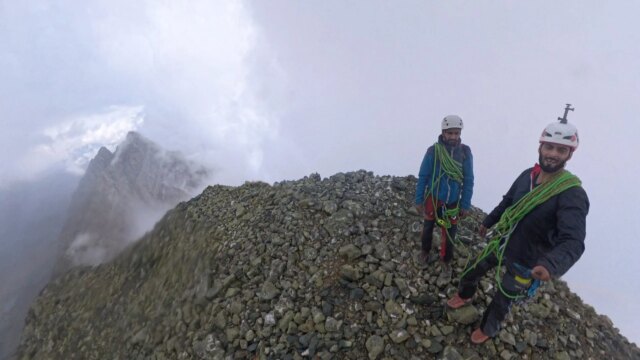Srinagar, Oct 5: At dawn on September 18, deep in the wilderness of Kulgam in South Kashmir, two Kashmiri alpinists clipped into their ropes and stared up at a sheer wall of hard rock. Rising 230 metres vertical rock wall, the feature was known locally as the Cathedral Dome, the crux of Brahma Sakli Peak, a 4,730-metre tower that had defied climbers for generations.
By 1:43 p.m., against whipping winds and shifting clouds, Inayat Ullah Bhat of Srinagar and his climbing partner, Laway Mudasir from Pahalgam, stood on the summit. For the first time in Kashmir’s climbing history, Brahma Sakli had been climbed through a full multi-pitch alpine rock route.
“This mountain was always considered unclimbable,” Inayat recalled, speaking after his return. “The final pitches demanded pure technical climbing. It felt like a battle against both the rock and the elements.”
The climb was not just a test of skill but of endurance. The duo had set off from their lakeside base camp at 5:00 a.m., moving steadily through steep gullies before confronting the Dome. Every pitch required careful belays, anchor placements, and split-second judgement. By the time they topped out, their bodies were spent, but the dream was alive.
The descent was no less punishing. Afternoon storms swept across the massif, rattling their ropes and reducing visibility. By the time they reached base camp again, it was 8:30 p.m., a full 18 hours since they had left.
A Centuries-Old Dream
Brahma Sakli has always carried a mythical weight. Rising like a sentinel at the southern end of the valley, its spires, sharp, trident-shaped rock towers, have stirred both reverence and fear. Old Himalayan climbing journals mention the peak only in passing, usually accompanied by a shrug, “forbidden”, “impossible”, or “best left alone”.
“Even as children, we would hear stories about these mountains,” said Inayat. “But back then, we didn’t have the gear, the exposure, or the infrastructure to even imagine climbing them. We were just school kids going on hikes.”
It wasn’t until the past decade, with more structured training and exposure, that a serious Kashmiri alpine community began to take shape. For Inayat and Mudasir, the Brahma Sakli project became a personal obsession, a way to prove that the Valley’s climbers could match the world’s toughest standards.
A Team of Two
While the ropes and anchors did the mechanical work, the heart of the climb was trust. Inayat led the push, while Mudasir, hailing from the alpine-rooted landscapes of Pahalgam, supported with equal passion.
“Mudasir was the backbone,” Inayat admitted. “You can’t fight such a wall without a partner who believes in the climb as much as you do. On multi-pitch climbs, your life is literally in your partner’s hands.”
Marking Alpine History
The ascent has already begun to ripple through Kashmir’s climbing circles. Multi-pitch alpine rock climbing is still new terrain in the Valley, where most expeditions have historically targeted snow-dome or trekking peaks. The Brahma Sakli climb marked a turning point, the first time Kashmiri climbers tackled such a technical rock face on their home turf.
The Road Ahead
For the duo, this is not the end, but the beginning. Their next goal, they say, is to revive forgotten peaks across the Valley and introduce Kashmir to the global map of technical climbing.
“It’s not just about gear or ropes,” Inayat said, his eyes fixed on future horizons. “It’s about creating an ecosystem where the next generation of Kashmiris can dream higher, climb harder, and know that even our ‘forbidden’ peaks can be reached.”
Brahma Sakli is no longer just a looming spire in the distance; it is now part of a living story of courage, partnership, and the belief that no mountain is truly unconquerable.








